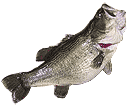Research/Academic Showcase
Texas Tech University
The Science of Hooking a Trophy Bass
National Journal Honors Chemistry Professor's Work
Three Honors College Students Score Goldwater Scholarships
Preserving Texas Music for Future Generations
Texas Tech University Health Sciences Center
School of Medicine Gets New Dean
Researcher Seeks Answers for Diabetes
Alumni Highlights
Local Alumni Association Chapters
Development
School of Pharmacy Program Expands to Abilene
From here, it's Possible Contest
Athletics
Kristy Curry Named Head Coach of Lady Raiders
Morgan Earns National Pitcher of the Week Honors
Texas Tech University Press
Take a Thrill Ride Among Southwest Fossil Digs in "Quarry"
Helpful Links
"The odds of hooking a trophy largemouth bass are at their best this year."
Dr. Gene Wilde

Research Shows Lure Size, El Niño Could Impact Bass Fishermen’s Odds
The Science of Hooking a Trophy Bass
Research/Academic Showcase
 Dr. Gene Wilde, associate professor of fisheries ecology with the Wildlife Fisheries Management Institute at Texas Tech University
Dr. Gene Wilde, associate professor of fisheries ecology with the Wildlife Fisheries Management Institute at Texas Tech UniversityThe odds of hooking a trophy largemouth bass are at their best this year, thanks to the El Niño* that rolled through in 1998, says Dr. Gene Wilde, associate professor of fisheries ecology with the Wildlife Fisheries Management Institute at Texas Tech University. Reservoirs filled by winter rains in El Niño years and booming populations mean bass are more likely to reach trophy size eight years later, his ongoing research shows.
“The conditions are conducive to the early survival of largemouth bass,” Wilde says. “In a sense, it’s like a big lottery – the more tickets you buy, the better chance you have of winning.”
And, for extra luck snagging big catches, try using larger lures. In a separate study, Wilde and Dr. Kevin Pope found that bigger lures could, in fact, lead to catches of bigger largemouth bass. What’s more, since it is almost physically impossible for small bass to swallow lures of a certain stature, the researchers suggest that the number and length of fish captured by anglers can be influenced by manipulating lure sizes.
Wilde and Pope, an assistant professor of fisheries management with the institute, conducted a series of angling experiments in a well-shaded pond using crank bait in a variety of sizes and colors, catching 500 fish on each lure size.
Based on their catch rates, the professors found that fishermen reduce their chances of catching smaller fish (those between approx. 14 and 15 inches long) by 47 percent if they are restricted from using smallest lure sizes.
This information could benefit places like hatcheries that are interested in minimizing the number of small fish caught by anglers. Lure-size restrictions could be used in recreational fisheries to reinforce size limits. By restricting the use of small lures, for instance, fisheries could help ensure anglers are not catching fish below a certain length.
Wilde has made a big splash in angling circles for his work with bass fish, but he also tackles critical issues facing Texas’ aquatic inhabitants. Among other studies, Wilde is currently researching sharpnose and smalleye shiners in the Brazos River. The silvery minnows can only be found in the Brazos and have been listed as candidate species on the U.S. Fish and Wildlife Service’s Endangered Species Act. Wilde is looking into whether dams and other development on the waterway are affecting shiner populations.
*El Niñois defined as sustained sea surface temperature anomalies of magnitude greater than 0.5°C across the central tropical Pacific Ocean.
Photo courtesy of Texas Parks & Wildlife. Visit their Web site to learn more about fishing in Texas.